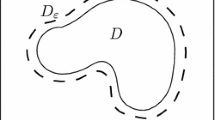Abstract
This work is devoted to finding the error estimates of the fictitious domain method for elliptic problems defined on the simply connected domain. We embed the given domain into a larger rectangular domain to use the uniform mesh and extend the variational form of the original problem onto a rectangular domain with a modified \(H^1\) penalty approach. We address the convergence of the new penalized problem for both continuous and discrete cases, and find the error estimates in \(H^1\) and \(L^2\) norms with the order of 1/2 and 1, respectively. In addition, numerical experiments are performed to guarantee the theoretical outcomes, and numerically, we obtain the optimal order of convergence for the proposed method.












Similar content being viewed by others
References
Adams RA (1975) Sobolev Spaces. Academic Press, New York
Adjerid S, Lin T (2009) A \(p-\)th degree immersed finite element for boundary value problems with discontinuous coefficients. Appl Numer Math 59:1303–1321
Angot P (2005) A unified fictitious domain model for general embedded boundary conditions. C R Acad Sci Paris Ser I 341:683–688
Brenner SC, Scott LR (2008) The mathematical theory of finite element methods. In: Texts in Applied Mathematics, 3rd ed., Springer, Vol. 15, New York, NY,
Burman E, Hansbo P (2014) Fictitious domain methods using cut element III. A stabilized Nitsche methods for Stoke’s problem, ESAIM: M2AN Vol 48, pp 859–874
Ciarlet PG (1977) The Finite Element Method for Elliptic problems. North-Holland
Del Pino S, Pironneau O (2003) A fictitious domain based general PDE solver. In: Kuznetsov Y, Neittanmaki P, Pironneau O (eds) Numerical Methods for Scientific Computing: Variational problems and Applications. Internat. Center Numer. Methods Eng, Barcelona
Girault V, Glowinski R (1995) Error analysis of a fictitious domain method applied to a Dirichlet problem. Jpn J Indust Appl Math 12:487–514
Glowinski R, Pan TW (1991) Error estimate for fictitious domain/penalty/finite element methods. Calcolo 29:125–141
Glowinski R, Pan T, Periaux J (1994) A fictitious domain method for Dirichlet problem and applications. Comput Methods Appl Mech Eng 111:283–303
Glowinski R, Pan T-W, Périaux J (1997) A Lagrange multiplier/fictitious domain method for the numerical simulation of incompressible viscous flow around moving rigid bodies: (I) case where the rigid body motions are known a priori. C R Math Acad Sci Paris 324:361–369
Glowinski R, Pan T-W, Hesla TI, Joseph DD (1999) A distributed Lagrange multiplier/fictitious domain method for particulate flows. Int J Multiph Flow 25:755–794
Glowinski R, Pan TW, Hesla TI, Joseph DD, Périaux J (2001) A fictitious domain approach to the direct numerical simulation of incompressible viscous flow past moving rigid bodies: application to particulate flow. J Comput Phys 169:363–426
Grisvard P (1985) Elliptic problems in nonsmooth domains, Monograph and studies in mathematics, vol 24. Pitman Advanced Publishing program, Boston
He X, Lin T, Lin Y (2012) The convergence of the bilinear and linear immersed finite element solutions to interface problems. Numer Methods Part Diff Equ 28(1):312–330
Hyman MA (1952) Non-iterative numerical solution of boundary value problems. Appl Sci Res Sect B 2:325–351
Küfner A, John O, Fucik S (1977) Function Spaces. Noordhoff International Publishing, Leyden
Li Z, Lin T, Wu X (2003) New Cartesian grid methods for interface problem using finite element formulation. Numer Math 96:61–98
Lin T, Lin Y, Zhang X (2015) Partially penalized immersed finite element methods for elliptic interface problems. SIAM J Numer Anal 53(2):1121–1144
Lions JL, Magenes E (1972) Non-Homogeneous Boundary Value problems and Applications, vol I. Springer-Verlag, New York
Liu GR (2002) Mesh free methods: moving beyond the finite element method. CRC Press, Boca Raton
Massing A, Larson MG, Rognes LME (2014) A stabilized Nitsche fictitious domain method for the Stokes problem. J Sci Comput 61:604–628
Mittal R, Iaccarino G (2005) Immersed boundary methods. Annu Rev Fluid Mech 37:239–261
Peskin C (2002) The immersed boundary method. Acta Numer 11:1–39
Strang G, Fix GJ (2008) An Analysis of the Finite Element Method, 2ed. Prentice- Hall series in automatic computation, Wellesley-Cambridge Press,
Suito H, Kawarada H (2004) Numerical Simulation of Spilled Oil by Fictitious Domain Method. Jpn J Indust Appl Math 21:219–236
Yin P, Liandrat J (2016) Coupling wavelets/vaguelets and smooth fictitious domain methods for elliptic problems: the univariate case. Comp Appl Math 35:351–369
Zhang S (2006) A domain embedding method for mixed boundary value problems. C R Math Acad Sci Paris 343(4):287–290
Zhang S (2008) Analysis of finite element domain embedding methods for curved domains using uniform grids. SIAM J Numer Anal 46(6):2843–2866
Zhou G (2018) The fictitious domain method with \(H^1\) -penalty for the Stokes problem with Dirichlet boundary condition. Appl Numer Math 123:1–21
Zhou G, Saito N (2014) Analysis of the fictitious domain method with penalty for elliptic problems. Jpn J Indust Appl Math 31:57–85
Zhou G, Saito N (2015) Analysis of the fictitious domain method with an \(L^2\)-penalty for elliptic problems. Numer Funct Anal Optim 36:501–527
Acknowledgements
The first author would like to express amiable thanks to Late Prof D R Patil for introducing him the mathematical analysis in his bachelor’s degree. The first author gratefully acknowledges the Council of Scientific & Industrial Research (CSIR), for the research fellowship, via file no. 09/992(0007)/2019-EMR-I. The authors also thank the Defence Institute of Advanced Technology, Pune, and DRDO for providing the research-friendly infrastructure and amenities. The authors are immensely grateful to the anonymous reviewers and the editor for their abundant guidance, which enriched this article.
Author information
Authors and Affiliations
Additional information
Communicated by Abimael Loula.
Publisher's Note
Springer Nature remains neutral with regard to jurisdictional claims in published maps and institutional affiliations.
Rights and permissions
About this article
Cite this article
Kale, S., Pradhan, D. Error estimates of fictitious domain method with an \(H^1\) penalty approach for elliptic problems. Comp. Appl. Math. 41, 27 (2022). https://doi.org/10.1007/s40314-021-01731-z
Received:
Revised:
Accepted:
Published:
DOI: https://doi.org/10.1007/s40314-021-01731-z
Keywords
- Finite-element method
- Domain embedding method
- Penalty method
- Curved boundary
- Uniform mesh
- Error estimates



